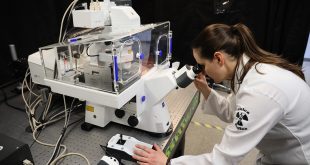10 women who broke barriers & made her-story
Last summer news came out that Donna Strickland became the third woman in history to win a Nobel Prize in Physics – among them, the only Canadian. A lone figure in the blinding glare of the world’s media, she stood for all trailblazing women of science – past, present and future. We wanted to take a closer look at some of the game-changing Canadian women in STEM, so here are 10 that everyone should know well.
Reaching for the stars: Roberta Bondar
The first Canadian female astronaut, as well as a physician, scientist and photographer, Roberta Bondar was aboard the Space Shuttle Discovery for its January 1992 mission, realizing a personal dream and capturing the imagination of millions. Upon her return, Bondar wrote Touching the Earth, a book in which she speaks of her space experience and her love of the planet.
For almost 20 years, Bondar has been on the scientific forefront in discovering how the brain adapts to unfamiliar environments. She headed an international team at NASA for over a decade that researched the connections between astronauts recovering from the microgravity of space and neurological illnesses here on Earth, such as stroke and Parkinson’s disease. Bondar’s techniques have been used in clinical studies at Harvard Medical School and the University of New Mexico.
Bondar also participated in the National Gallery of Canada’s landmark exhibition “Science and Photography: Beauty of Another Order,” and she photographed all of Canada’s national parks for Passionate Vision: Discovering Canada’s National Parks, published by Douglas & McIntyre. Her book Canada: Landscape of Dreams is now in its second printing.
Bondar now applies her insights and lessons learned from the unpredictable environment of space to today’s constantly changing business environment. She created HyperThink, a perspective and process that helps companies make adaptive decisions when entering uncharted territory.
Among her numerous distinctions, Bondar has been honoured as a Fellow of the Royal Society of Canada, inducted into the Canadian Medical Hall of Fame for her pioneering research in space medicine, named by TIME magazine as one of North America’s Best Explorers and recognized with the Order of Canada and the NASA Space Medal. In addition, she has received 24 honorary doctorates from Canadian and American universities. Dr. Roberta Bondar is truly a Renaissance woman.
A real “Goh” getter: Cynthia Goh
Cynthia Goh, founder of the Impact Centre at the University of Toronto (UoT), always loved science. It began in fifth grade, in a remote part of the Philippines, after reading a book on the universe. Since then, she’s made science her business – and a business out of science.
Although Goh is a physical chemist working in biomaterials, nanotechnology and biodiagnostics, she’s also a start-up champion, bringing scientific discoveries to market. At the Impact Centre, which she officially established in 2013 with a mission to bring science to society, she leads a team of researchers and advisors working to transform ideas into products and services.
Her expertise in scientific entrepreneurship has been sought after by participants in her training programs, like Entrepreneurship101 (E101) and Techno. E101 became the flagship training program at Toronto’s MaRS Discovery District and is offered online to over 10,000 individuals annually. Techno has led to the creation of over 160 start-ups and collectively, Techno start-ups have received funds in excess of $80M from public and private sources.
Together with her students, Goh founded seven companies, beginning in 2001 with Axela Biosensors Inc., which produces a commercial instrument used by researchers and clinicians for a variety of applications in the bio and medical areas. Other companies include Vive Crop Protection, which offers an eco-friendly pesticide delivery system to Canadian and U.S. markets; Pueblo Science, a not-for-profit that develops hands-on training for teachers in low-resource communities worldwide, reaching over 10,000 teachers in eight countries; Sciventions, a nanomaterial e-commerce platform; and Phantin, an environmental coatings company which was introduced in 2015 with sales in China.
When Goh isn’t in a business suit pushing commercialization of the next start-up, she’s in a lab coat at UoT. Goh has developed numerous technologies and more than 75 patents, for which she was awarded UoT Inventor of the Year in 2014.
A golden opportunity: Anna Goldenberg
Anna Goldenberg is breaking ground in her new role at Toronto’s Hospital for Sick Children as its inaugural chair in biomedical informatics and artificial intelligence – the first post of its kind to exist in a Canadian children’s hospital.
“I feel like right now as a computer scientist, as a researcher in machine learning and AI, I can actually make a big difference in health care,” Goldenberg told The Globe and Mail. “It will take time, but I think we are getting closer and closer to seeing it happen.”
Goldenberg’s research centres on how machine learning can be used to map human disease heterogeneity. At SickKids, where she already works as a senior scientist, she has two trillion data points to work with, collected from the hospital’s 42 intensive-care beds. Her current research at SickKids uses patient data and AI to predict cardiac arrest before the heart stops beating – a model the hospital is testing to serve as an early warning system for its young patients. The position is being funded in part by a $1.75 million donation from Toronto entrepreneur Amar Varma, whose son underwent surgery at SickKids six years ago.
Goldenberg is an expert in developing machine learning approaches for biological data, network methods and most recently, data integration of omics and clinical data. The current focus of her lab is on developing methods that capture heterogeneity and identify disease mechanisms in complex human diseases. Her translational focus is on methods that efficiently combine many types of patient measurements to refine diagnosis, improve prognosis and personalize drug response prediction for patients with complex human diseases.
Doing the neutron dance: Victoria Kaspi
In 2016, Victoria Kaspi, a McGill University astrophysicist, became the first woman to win Canada’s top science prize, the Gerhard Herzberg Canada Gold Medal from the Natural Sciences and Engineering Research Council of Canada (NSERC). Kaspi accepted the award on behalf of her research group, a team responsible for several major discoveries in the field of astrophysics.
Fascinated by the night sky and the mysteries of the universe since childhood, Kaspi is described by NSERC as one of the world’s leading experts on neutron stars, the ancient remnants of the most massive stars in the Milky Way.
“Part of understanding the formation of neutron stars is understanding the origin of all matter,” she says in an NSERC video. Neutron stars offer this opportunity because of their extreme gravitational and magnetic forces; they can be as small as several kilometres across, but more massive than the Sun. “If you take a teaspoon full of a neutron star, it weighs a billion tonnes,” Kaspi explains. “This is not like matter we’re familiar with here on Earth. And yet it is a form of matter that can exist in the universe, and we’re trying to understand the nature of that matter.”
Among Kaspi’s achievements, she discovered a pulsar that rotates at 716 times per second, the fastest speed to date. Her team’s 2002 landmark discovery of powerful X-ray bursts from an enigmatic class of star essentially doubled the number of known magnetars in our galaxy. Using observations of a binary pulsar – two pulsars orbiting each other – she deployed a new test to validate Albert Einstein’s general theory of relativity. In 2013, Kaspi published her discovery of a second magnetar in our galaxy – a rare type of star with a colossal magnetic field and strange behaviour.
Kaspi’s study of neutron stars also earned her the NSERC John C. Polanyi Award, which honours an individual or team whose Canadian-based research has led to outstanding advances in the natural sciences or engineering.
Pioneer, war hero and role model: Elizabeth (Elsie) MacGill
Last year, the Bank of Canada released a new $10 bill, making history by featuring a woman: social justice defender Viola Desmond. It was a good choice, but cannot have been easy to make because among the iconic list of Canadian women was another contender, Elsie MacGill. Born in 1905, she was the first practicing female engineer in Canada and the world’s first female aircraft designer; she was also a Canadian war hero, as the only woman to lead a major wartime production plant. In 1938, she became the chief aeronautical engineer for Canadian Car & Foundry (CanCar) in Fort William, where she retooled the plant for mass production of the Hawker Hurricane fighter planes during World War II – a role that won her the nickname “Queen of the Hurricanes,” and in no small way helped the Allies win the war. The plane was one of the main fighters in the Battle of Britain. At the time, 60 percent of air victories by the Royal Air Force involved this single-seat fighter aircraft. At CanCar, MacGill also designed, built and tested the Maple Leaf II Trainer. She re-engineered the plane, based on a previous model, and brought it to aerial testing. It never went into full production in Canada, but is recognized as the first aircraft designed and built by a woman. Ironically, this Canadian strongwoman needed a cane to help her maneuver through the assembly lines, having lost her mobility to polio after graduating from university.
An active Canadian feminist, MacGill served two years as national president of the Canadian Federation of Business and Professional Women’s Clubs and was a member of the Royal Commission on the Status of Women in Canada in the late 1960s. Her articles on aviation appeared in many publications, even those with female audiences, like Chatelaine and Vogue. She was pivotal to building diversity in the Canadian engineering profession, and planted the roots for initiatives that encourage women to pursue engineering. Ninety years later, according to Engineers Canada, women continue to be significantly underrepresented in the engineering profession, where less than 13 percent of practicing licensed engineers are female.
Engineering phenom: Veena Rawat
It was at her convocation ceremony in 1973 that Veena Rawat heard herself described as the first woman to receive a PhD from the Department of Electrical Engineering at Queen’s University. It was a “first” she had seen before, having been the only woman in her undergraduate class at the University of Rajasthan in India, and again when working on her Master’s degree. Several “firsts” followed.
Promoting Canadian innovation and working with international partners has been an important part of Rawat’s work. In 2003, she became the first woman to chair the United Nations’ International Telecommunications Union (ITU) World Radio Conference. In this role, she worked with 192 delegates on formal resolutions to bind all nations on allocations of channels for various communications. For her successful leadership of the conference, Rawat received a gold medal from the Secretary-General of the ITU.
After 2003, Rawat joined the Communications Research Centre (CRC), an agency of Industry Canada, becoming its first female president a year later. Under her leadership, the CRC extended broadband services to remote and rural areas, improved search and rescue satellite-aided tracking, and developed the world’s first WiFi-based cognitive radio-development platform.
Rawat’s doctoral research at Queen’s University was on creating optimal communications in remote locations, testing cables to see how they transmitted radio signals in underground mines and tunnels. It was research she completed despite being barred from entering an active mine because she was a woman, relying on male colleagues to collect the data on location for her. The research completed, Rawat successfully defended her thesis, “Unorthodox transmission lines for continuous access guided communications.”
After retiring from a 36-year career in federal public service, which included six years as president of the Communications Research Centre, Canada’s centre of excellence for telecommunications, Rawat was hired by RIM as Vice-President, Advanced Technology Team. She also serves as RIM’s Ambassador to the International Telecommunication Union (ITU), an agency of the United Nations.
These days, the wireless communications expert does her best to mentor and inspire both women and men in the field she loves, urging engineering students to take a global view of the job market.
Statistical powerhouse: Nancy Margaret Reid
Nancy Margaret Reid, professor of statistics at the University of Toronto, is challenging the odds for women in STEM. “One of my probability professors once stated in class that, ‘Women are not suited for mathematics.’ We’ve come a long way since then, but we still have a relatively small number of women in leadership positions,” she says, adding that change needs to happen or Canada will miss out on a lot of talent.
Reid explores the boundary between theoretical statistics and real-world applications. She teaches both advanced statistical theory to graduate students and a course on “Lies, Damned Lies and Statistics” to first-year classes.
Reid was the first woman to receive the prestigious international Presidents’ Award from the Committee of Presidents of Statistical Societies, and she was President of the Institute of Mathematical Statistics (1997). She believes that “statistics is a great way to apply mathematics to a wide variety of areas of science and social science – problems in cancer treatment, climate modelling, educational testing, and many other fields. Finding the common thread in these problems is the challenge of theoretical statistics.”
Last spring, The Royal Society announced that Reid was one of 50 U.K. and commonwealth scientists selected to become the society’s newest fellows. She shares this year’s honour with some of the world’s most eminent researchers and innovators.
Over her career, Reid has been an important contributor to the field of theoretical statistics, especially in the area of statistical inference – making sense of large and complex sets of data.“Whether you are studying health or air pollution or you’re discovering new planets, almost every scientist uses statistical analysis in one way or another,” says Reid. “A theoretical statistician like me basically studies an abstract version of a problem. I try to find the common threads between different research areas in order to make statistical methods more accurate and efficient, so that scientists across disciplines can extract the best possible information from data sets.”
Over the years, recognizing and supporting women in STEM fields has increasingly become a priority for her, Reid says. To draw attention to gender barriers and inequality in her field, Reid wrote an essay in 2014 titled “The Whole Women Thing,” examining cognitive biases that impact the advancement of women in statistical science.
Helping invent the future: Molly Shoichet
By becoming Ontario’s first chief scientist in 2017, Molly Shoichet hoped to grow public trust in science and help the government make better-informed decisions based on evidence. The award-winning biomedical engineer aimed to build Ontario’s reputation for innovation. Half a year later and just days after the new progressive conservative government was sworn in, the position was cancelled.
Shoichet holds the Canada Research Chair in Tissue Engineering at the University of Toronto and, among numerous awards, received the Order of Canada in 2018 and the Killam Prize for Engineering in 2017 for her work on tissue and polymer engineering, focusing on targeted drug delivery, tissue regeneration and stem cell research. Shoichet is a strong advocate of women in science and technology, a career she decided to pursue because, she says, “I got really excited about this idea of inventing the future, coming up with strategies that would make a difference in people’s lives, instead of applying what we already know.”
To expose the public to science, she cofounded Research2Reality, which produces short, accessible videos showcasing scientists’ work, and airs them on social media and at public events. Shoichet also helped organize an exhibit of images from research laboratories featuring everything from biological cells to lakes and oceans, called “Inner Spaces,” at the Ontario Science Centre last May.
Steering MaRS: Ilse Treurnicht
Ilse Treurnicht became the first CEO of Toronto’s MaRS Discovery District in 2005, assuming the helm of what grew to become a world-renowned innovation hub under her leadership. The centre has since doubled in size and is now home to some 6,000 people from 150 organizations, which collectively raised over $3.5 billion for business development in areas that include health, cleantech and fintech.
Key to MaRS’s success has been Treurnicht’s commitment to building a dynamic, collaborative atmosphere that brings together educators, researchers, entrepreneurs and business types in a single space, allowing innovative ideas to converge. Here, specialized infrastructure as well as access to critical talent, capital and customer networks helps innovators and entrepreneurs build high-impact growth businesses.
Before joining MaRS, she was CEO of Primaxis Technology Ventures, and was an entrepreneur and executive in several emerging technology companies. Treurnicht was Chair of the Canadian Task Force on Social Finance in 2010, served on the Government of Canada’s Science, Technology and Innovation Council (STIC), and is a member of the Advisory Council on Economic Growth. She chairs the board of Triphase Accelerator Corporation, a cancer drug development firm, and serves on the boards of Cogniciti, a brain health company, and Canada’s Public Policy Forum. Treurnicht retired from MaRS in 2017.
First female Nobel laureate: Donna Strickland
Last year Donna Strickland became the first Canadian woman to receive the Nobel Prize in Physics for developing chirped pulse amplification (CPA), a prize she shared with her PhD supervisor Gérard Mourou. They published their research in 1985 when Strickland was a PhD student at the University of Rochester in New York State. The work paved the way for the most intense laser pulses ever created, opening the door to what has become routine laser eye surgery today as well as laser-based cameras that are now used in laboratories around the world to create ultra-slow-motion movies of chemical and physical reactions.
Strickland and Mourou developed a solution that resolved the problem of amplifying beams without damaging the laser amplifier in the process. They realized that by stretching, amplifying and then compressing the beams, they could boost the intensity of the light dramatically. This allowed more light to be packed into a shorter time, increasing the intensity of the pulse, while allowing laser beams to cut into matter with extreme precision. The technique allowed lasers to become more useful to scientific, industrial, medical, energy, military and security communities.
Before earning her PhD, Strickland
completed a bachelor of engineering degree at McMaster University. From 1988 to
1991, she was a research associate at the National Research Council Canada,
where Strickland worked on ultrafast phenomena. After a stint as a physicist at
Lawrence Livermore National Laboratory, she joined Princeton University’s
Advanced Technology Center for Photonics and Optoelectronic Materials. In 1997,
Strickland became the second female professor of physics at the University of
Waterloo, where her ultrafast laser group develops high-intensity laser systems
for nonlinear optics investigations. In 2013, Strickland served as the
president of the Optical Society (OSA) and is an OSA Fellow. She is also a
recipient of a Sloan Research Fellowship, a Premier’s Research Excellence Award
and
a Cottrell Scholar Award.
 BioLab Business Magazine Together, we reach farther into the Canadian Science community
BioLab Business Magazine Together, we reach farther into the Canadian Science community






